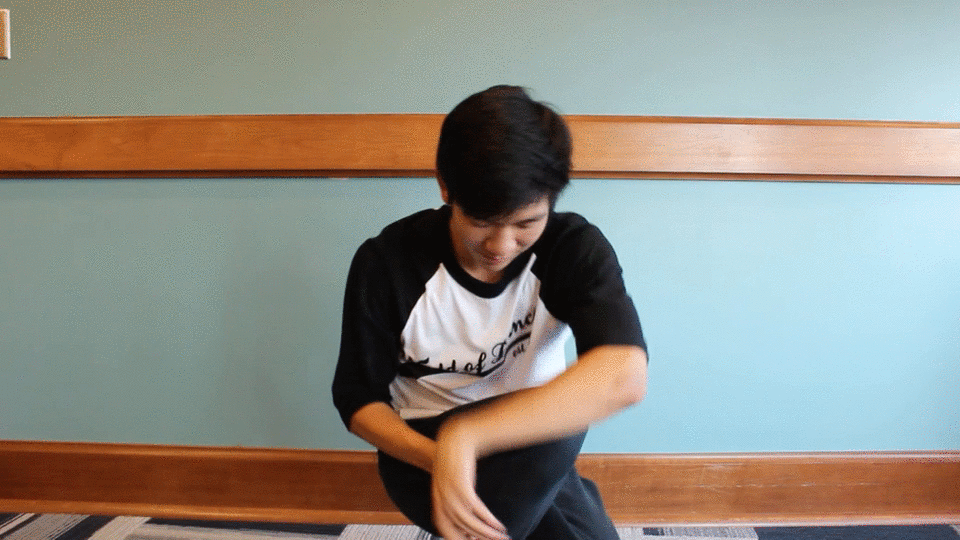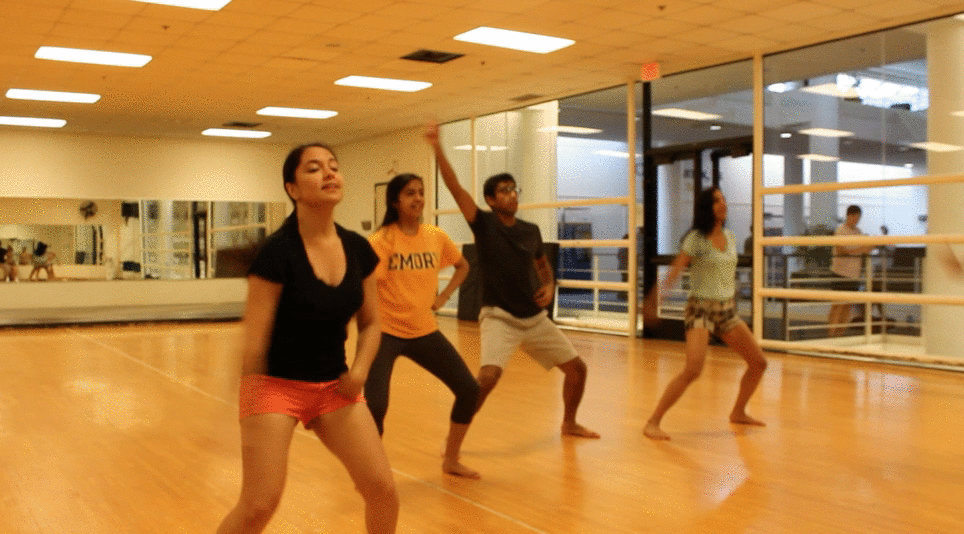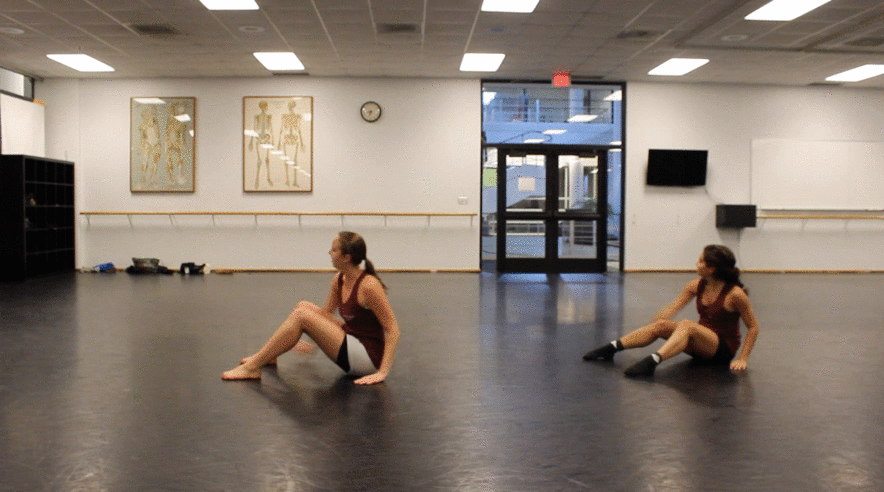During the first week of classes at Emory, dancers could be spotted rehearsing for auditions throughout campus. Walking to the Woodruff P.E. Center (WoodPEC), you would have seen girls running through an AHANA Dance combination on the carpet outside of the WoodPEC dance studio, or you might have seen a group of friends rehearsing for hip-hop group Adrenaline while you were running on the track. Even if you were heading toward the Goizueta Business School, you might have seen a dancer practicing pirouettes for an Emory Dance Company (EDC) callback.
There is richness in the dance community at Emory, with diversity in the levels and styles of dancers. Currently, there are over 15 student-run dance groups, featuring dancers of all experiences from those who have no dance experience to those who have years of formal training.
In the student-run dance groups, students perform, create, collaborate, compete and practice dances that range in style from contemporary jazz and bhangra to breakdancing.

College junior and TNT co-captain Sean Chew demonstrates “tutting,” a dance technique involving quick hand motions. / Julia Munslow, Asst. Arts & Entertainment Editor
As a first year, walking into an audition room filled with unfamiliar faces can be, to say the least, intimidating. Despite my own nerves and uncertainty, I decided to audition for AHANA.
AHANA — which stands for African, Hispanic, Asian, Native American, and all other artists collective — allows choreographers to see their pieces come to life by auditioning dancers for each of their respective pieces. The group gives the choreographers space to rehearse and enables them to see their production come together in a semi-annual performance at the Burlington Road Building.
When everyone auditioning arrived at the WoodPEC studio, we were each given a number to pin onto our clothes. Once the auditions began, about 75 of us sat on the marley floor of the studio and awaited instructions.
Nine student choreographers, as well as AHANA faculty coordinator and Emory dance instructor Tara Shepard Myers, demonstrated 30-second snippets of their pieces. After viewing parts of each of the pieces, we prepared to sign up for the dances for which we wanted to audition.
Two members of the AHANA executive board taught a short combination to “Lean On” by Major Lazer. The girls leading the combination, College sophomores Emily Sullivan and Catherine Messina, were friendly, approachable and expressed their willingness to go over the dance as many times as needed before we continued on.
After waiting outside, AHANA called us in by our numbers to perform the short combination twice for the choreographers.
While I’ve auditioned for two other dance groups, I’ve never auditioned for my peers. Although it was uncomfortable to audition for a piece choreographed by a friend, it made the entire audition process easier. Asking another student what dance count to kick your right leg up on is much less nerve-wracking than asking the same of a professional choreographer.

Dance team Karma Bhangra practices bhangra steps in the WoodPEC Multipurpose Room. / Julia Munslow, Asst. Arts & Entertainment Editor
College freshman Anya Shikhman, who auditioned for AHANA, said she did not necessarily feel that auditioning for students rather than for older, professional teachers relieved any pressure.
“[Auditioning for students can be] just as intimidating,” Shikhman said. “They are students, just like us, but they are [still] judging us.”
Many other auditions were held this week for dancers, for both student-run dance groups and for EDC.
College freshman Sylvie Moscovitz auditioned for EDC and E-Motion, Emory’s official dance team. Moscovitz explained that while both the auditions for EDC and E-Motion were judged by professional choreographers including three Emory faculty, that E-Motion’s audition was less stressful.
“It was definitely scary being a freshman at both auditions,” Moscovitz said. “But it felt more happy and relaxed at E-Motion because it was pretty much [only] freshmen auditioning. All of the upperclassmen had [separate] auditions.”
Shikhman, while also anxious, had a different perspective.
“For me, even though I’ve had a lot of dance competition experience and been to a bunch of auditions, it was still intimidating,” Shikhman said. “[It wasn’t] even because I was a freshman, but more because it was the idea and label of it [as] being an official ‘audition.’”
College freshman Jacob Robbins, who auditioned for EDC and has been trained in a range of different dance styles since sixth grade, echoed Shikhman’s sentiments.
“Auditioning for EDC was both nerve-wracking and exciting,” Robbins said. “I was thrilled to have the opportunity to join a dance company again. While it was pretty similar to auditions I’ve done before, with being given a number and stuff like that, I was intimidated because I’ve never done EDC before and didn’t know what it was going to be like.”

Members of AHANA Executive Board and College sophomores Emily Sullivan and Catherine Messina practice in the WoodPEC dance studio. / Julia Munslow, Asst. Arts & Entertainment Editor
College junior and Adrenaline member Ruchi Ahuja compared auditioning as a first year to auditioning as a junior.
“[As a freshman], it was more intimidating because I didn’t come to college with much dance experience,” Ahuja said. “Also, when you go to an audition, you know it’s going to be [with some] people who already have established relationships with those on the team … you don’t want that to affect the audition process, but [at] some level, it does.”
However, Ahuja’s previous experiences have given her an increased level of confidence today.
“I feel more confident now,” she said. “It’s different when the people you are auditioning for already know how you move. They have seen you dance before, so there’s not as much pressure, and it makes things easier.”
Just like almost all new experiences at Emory, auditioning for a dance group as a freshman can be equally as uncomfortable and challenging.
The most difficult part of auditioning for AHANA was simply the uncertainty of it all: it was about being fairly new to the audition process as a whole, while also being new to the school.
However, the excitement, pleasure and fun that seems to come with being a part of dance at Emory makes all of the doubts that come with such new challenges worth it.






